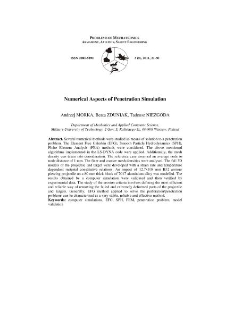Nasza Biblioteka Cyfrowa udostępnia 1 868 obiektów cyfrowych
Obiekt
Tytuł: Numerical Aspects of Penetration Simulation ; Numerical Aspects of Penetration Simulation
Współtwórca:
Beata ZDUNIAK, Tadeusz NIEZGODA ; Beata ZDUNIAK, Tadeusz NIEZGODA
Abstrakt:
Several numerical methods were studied as means of solution to a penetration problem. The Element Free Galerkin (EFG), Smooth Particle Hydrodynamics (SPH), Finite Element Analysis (FEA) methods were considered. The above mentioned algorithms implemented in the LS-DYNA code were applied. Additionally, the mesh density was taken into consideration. The reference case assumed an average node to node distance of 1 mm. The finer and coarser mesh densities were analysed. The full 3D models of the projectile and target were developed with a strain rate and temperature dependent material constitutive relations. An impact of 12.7x108 mm B32 armour piercing projectile on a 80 mm thick block of 7017 aluminium alloy was modelled. The results obtained by a computer simulation were validated and then verified by experimental data. The study of the erosion criteria involves defining the most efficient and reliable way of removing the failed and extremely deformed parts of the projectile and targets. Generally, EFG method applied to solve the perforation/penetration problems can be characterized as a very stable, reliable and effective method.
;
Several numerical methods were studied as means of solution to a penetration problem. The Element Free Galerkin (EFG), Smooth Particle Hydrodynamics (SPH), Finite Element Analysis (FEA) methods were considered. The above mentioned algorithms implemented in the LS-DYNA code were applied. Additionally, the mesh density was taken into consideration. The reference case assumed an average node to node distance of 1 mm. The finer and coarser mesh densities were analysed. The full 3D models of the projectile and target were developed with a strain rate and temperature dependent material constitutive relations. An impact of 12.7x108 mm B32 armour piercing projectile on a 80 mm thick block of 7017 aluminium alloy was modelled. The results obtained by a computer simulation were validated and then verified by experimental data. The study of the erosion criteria involves defining the most efficient and reliable way of removing the failed and extremely deformed parts of the projectile and targets. Generally, EFG method applied to solve the perforation/penetration problems can be characterized as a very stable, reliable and effective method.
Miejsce wydania:
Warszawa
;
Warszawa
Wydawca:
Wojskowa Akademia Techniczna ; Wojskowa Akademia Techniczna
Data utworzenia:
Data wydania:
Rozmiar:
Identyfikator:
oai:ribes-88.man.poznan.pl:2331
ISSN elektroniczny:
ISSN drukowany:
Język:
Właściciel praw:
Wojskowa Akademia Techniczna ; Wojskowa Akademia Techniczna
Strona początkowa:
Strona końcowa:
Tom:
Słowa kluczowe:
computer simulations, EFG, SPH, FEM, penetration problem, modelvalidation ; computer simulations, EFG, SPH, FEM, penetration problem, modelvalidation
Kolekcje, do których przypisany jest obiekt:
Data ostatniej modyfikacji:
12 sie 2025
Data dodania obiektu:
12 sie 2025
Liczba wyświetleń treści obiektu:
0
Wszystkie dostępne wersje tego obiektu:
https://ribes-88.man.poznan.pl/publication/2631
Wyświetl opis w formacie RDF:
Wyświetl opis w formacie OAI-PMH:
| Nazwa wydania | Data |
|---|---|
| Numerical Aspects of Penetration Simulation | 12 sie 2025 |

